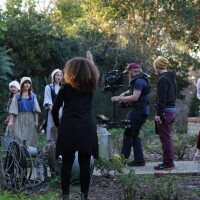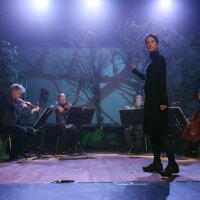From Alcatraz to a Redwood Forest: Seven Unusual Locations Used in 'Vireo'

Vireo, the groundbreaking made-for-TV opera, is now available for streaming. Watch the 12 full episodes and dive into the world of Vireo through librettos, essays and production notes. Find more bonus content on KCET.org and LinkTV.org.
In "Vireo: The Spiritual Biography of a Witch's Accuser," opera takes a new shape for the 21st century. The story of a teenage girl moves across centuries, illustrating the way that female hysteria has been historically handled, and is presented as an episodic web series. While portions of the opera were filmed inside theaters and studios, other times, the production moved out on location, heading to a Southern California farm, a New York retreat center and even Alcatraz.
"Vireo" was made over a period of two years and, similar to a television show, was written as the production moved forward. Composer Lisa Bielawa said that the locations did at times influence her writing. "As we started to get more inventive and challenge each other more with locations, then, of course I started to take that into account for sure," says Bielawa, adding that they would confirm the location before she had finished writing the music.
Below, we look at seven of the unusual locations used in "Vireo" and how they helped this opera take shape.
1. The Farm
Thanks to a member of the "Vireo" design team, the production had access to Shadow Hills Farm as a location for the fifth episode, "The Cow." The episode centers on the Cow's death and features a lot of performers, from milkmaids to a marching band. Being on a farm provided a lot of space, but with an additional logistical challenge. Conductor Lisa Bielawa recalls the scene where milkmaids line a path heading from a house to a barn. "I needed three conductors because nobody could see me conducting," she says. "There were no sight lines. There were big distances between the groups."

2. The Courtroom
If the courtroom in episode six, "Boarding School," looks a bit like a church to you, well, there's a reason for that. This is one of two episodes filmed at the Garrison Institute in Garrison, New York. Now a destination for retreats, the site was once a monastery, lending the space the kind of "semi-medieval" look that Charlie Otte wanted to see in this episode.
Otte is based between Los Angeles and New York and Bielawa is based in New York, so getting an East Coast shoot together wasn't that difficult. During the shoot, the team was able to stay at the Garrison Institute. "Since it used to be a monastery, it has a lot of rooms," says Otte. Staying overnight, he adds, helped them get to work early too.

3. The Well
The eighth episode, "Girl in the Well," was filmed at the same site as "Boarding School." In fact, Otte notes that you can see the exterior of the building that holds the courtroom over a wall early in the episode. "We always try to shoot a couple locations together on location," says Otte. "I I thought that if we could combine episode six and episode eight in one location, then I could get those done in two days."

4. Alcatraz
For episode nine, "Alcatraz," the team behind "Vireo" took on their most ambitious location shoot of the production. Director Charlie Otte says that the idea to shoot at Alcatraz came about after a conversation with composer Lisa Bielawa. Otte says that he was thinking of an "archetypal image for a prison."
"Alcatraz immediately come to mind," he said.
They reached out to the National Park Service and were able to secure permission to film. As Otte pointed out in Artbound's behind-the-scenes look at "Vireo," they had to work around tourist hours, which meant prepping for the shoot early in the morning and filming for a few hours at night.
Bielawa notes that, like working on the farm, Alcatraz required more than one conductor to work in the space. There were technical challenges too, like wireless microphones that stopped working. "We had all kinds of crazy ghosts in the machines out there," she says.
It certainly wasn't an easy shoot. "Rowen [Sabala, who plays Vireo] says that was her favorite shoot and also the most difficult day of her life," says Bielawa. "I can't believe that she pulled off that aria in that situation that she was in, with fifty people running around, running out of time."

5. The Car
In tenth episode, "Ice on the Sargasso," Vireo and Caroline go for a ride (with a hurdy-gurdy player) in a Valiant. The classic car was suggested by librettist Erik Ehn. Director Charlie Otte says they found a few such cars in San Francisco, where they were filming. "There were a few in disrepair," he says. "One would have to have been towed." Ultimately, though, they found a 1968 model that had been kept in great condition. It could run and had a lovely paint job. "It was perfect," says Otte. He adds that the white interior fit with the theme of the episode, where the characters are traveling through Sweden. The color, says Otte, helped mark the the story's transition to its circus-inspired culmination.

6. The Circus
As "Vireo" nears its conclusion, the production headed to an old venue with a spooky look to film episode 11, "Circus." The circus-like scene where Vireo is presented as a case study was filmed in Oakland at the abandoned 16th Street train station. "We were in San Francisco looking for a space to do a circus," says Otte. "We looked at some circus schools in different locations, but this had the appropriate haunted feeling and it was big enough where we could essentially set up an indoor circus."

7. The Forest
In the final chapter, "My Name Is Vireo," the protagonist's story concludes with her singing in Samuel P. Taylor State Park. The redwood forest scenes are cut together with a studio-filmed performance. They shot inside first, then brought singer Rowen Sabala out to the forest to finish work. Bielawa was able to conduct Sabala -- who has perfect pitch -- from memory.






